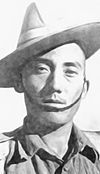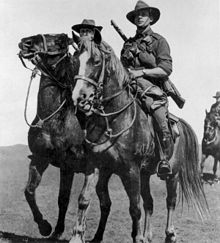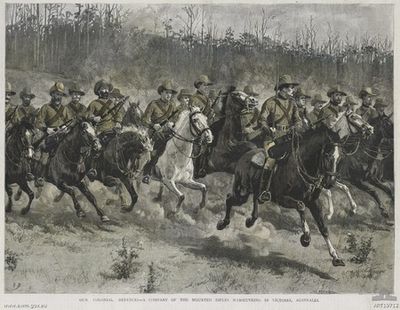- Slouch hat
-
 Slouch hat during the American Civil War
Slouch hat during the American Civil War
A slouch hat is a wide-brimmed felt or cloth hat with a chinstrap, most commonly worn as part of a military uniform. It is a survivor of the felt hats worn by certain 18th century armies. Since then, the slouch hat has been worn by military personnel from many nations including Australia, Britain, India, New Zealand, Southern Rhodesia, France, the United States, Germany and many others. Australia has had a slouch as standard issue headwear since the late Victorian Era. Today it is worn by military personnel from a number of countries, although it is primarily associated with Australia, where it is considered to be a national symbol. The distinctive Australian slouch hat, sometimes called an Australian bush hat or digger hat, has one side of the brim turned up or pinned to the side of the hat with a special badge (the bayonet collection badge, or the rising sun badge) in order to allow a rifle to be slung over the shoulder. In the United States it was also called the Kossuth hat, after Lajos Kossuth, and was a common article of both the Union and Confederate Armies officer's uniform.
Contents
History
 Naik Agansing Rai VC, 5th Royal Gurkha Rifles (Frontier Force)
Naik Agansing Rai VC, 5th Royal Gurkha Rifles (Frontier Force)
The name "Slouch Hat" refers to the fact that one side droops down as opposed to the other which is pinned against the side of the crown.[1] This style of hat has been worn for many hundreds of years, especially during the English Civil War during the 17th century when it became associated with the forces of King Charles I, the Cavaliers, but it was also fashionable for the aristocracy throughout Europe during that time until it was superseded by the cocked hat which in modern times has been referred to as the tricorn or bicorn depending upon the depth of the forward peak.
Despite being primarily associated with Australia, the slouch hat style did not originate in Australia; it was created in Nepal. It was introduced into Australia around 1885, and was sometimes described as a "Tyrolean" import, derived from the black "Corsican hat" (Korsehut) with a feather and a leather chinstrap; this hat with an upturned brim was worn by the fifteen battalions of Austrian light troops formed in 1801 after the French Revolutionary Wars. A contemporary painting dated 1884 (in the regimental museum) of the pipe band of 1st Battalion Argyll & Sutherland Highlanders in service dress, crossing the veldt in Zululand, shows them wearing khaki slouch hats.
A shortage of cork helmets led to the widespread use of the slouch hat amongst British Empire forces during the Second Boer War,[2] where it was used by units such as the City Imperial Volunteers (CIV), Imperial Yeomanry, and King Edward's Horse. After the war, however, many armies rejected the once-popular headwear (as the British Army did in 1905), although it came back into fashion briefly during World War II during the Burma campaign and amongst troops serving in India and Southeast Asia at this time.[3]
The slouch hat in gray felt was worn by the Schutztruppe (protection force), the colonial armed force of Imperial Germany, as an alternative to the pith helmet, especially in South West Africa. Different coloured puggarees were worn by the Germans in South West Africa, German East Africa, German West Africa (Togo and Cameroon) and China. The hat had its brim pinned up on the right side with a cockade in the national colors and was worn with the home uniform as well. German colonial police units in South West Africa wore a khaki slouch hat with a small national cockade on the front and the right side pinned up by a metal Imperial crown device.
The slouch hat was frequently worn throughout Africa and in motion pictures about Africa such as Jungle Jim and safari films.
It became associated with the Australian military around the end of the 19th Century and since World War I it has been manufactured in Australia by the Akubra company for the Australian Army. This slouch hat is still worn by the Australian military today and it has become a national symbol in Australia. A Unit Colour Patch is also worn by members of the Australian Army on their Slouch Hat to indicate which unit they are from.
The slouch hat or Terai hat is also associated with the Gurkha regiments of the British Army and Indian Army (formerly the British Indian Army) and is still worn by the Gurkhas; the hat is no longer worn on active service. The 2nd Gurkha Rifles became the first Gurkha regiment to adopt the slouch hat when they were issued with the Australian variant in 1901. The Gurkha terai hat is created by fusing two hats into one to make the hat more rigid and is worn at an angle, tilted to the right.
The Chindits and other units of Field Marshal William Slim's British Fourteenth Army, who fought against the Japanese in the Far East during World War II, also became associated with the slouch hat (also known as the bush hat in the British Army).[4] The slouch hat was also used by colonial units of the British Empire, including the Royal West African Frontier Force, the Canadian Yukon Field Force, Canadian Pacific Railway Militia, the Kenya Regiment and troops from Rhodesia.
Slouch hat in Australia
The slouch hat was first worn by military forces in Australia in 1885 when the newly created Victorian Mounted Rifles wore the hat as part of their khaki uniform. On 22 December 1890, the military commanders of the then separate Australian Colonies prior to the Federation of Australia met to discuss the introduction of the khaki uniform throughout Australia. They agreed that all Australian Forces with the exception of the Artillery would wear the slouch hat. It was to be looped up on one side — Victoria and Tasmania on the right and the other colonies (later states) on the left.[5] This was done so that rifles could be held at the slope without damaging the brim.[2]
After Federation, the slouch hat became standard Australian Army headgear in 1903 and since then it has developed into an important national symbol.[2]
 Australian Light Horse troops wearing slouch hats, November 1914.
Australian Light Horse troops wearing slouch hats, November 1914.
The Slouch hat (also known as a Hat KFF, or Hat Khaki Fur Felt) is worn as the standard ceremonial headress for all members of the army, except those belonging to units or corps that have an official headress, e.g., some units wear a beret. As such, it is treated with the utmost care and respect. The Grade 1 Slouch hat is worn with a seven band puggaree, said to represent the six states and the territories of Australia, the soldiers' Unit Colour Patch[6] (right of puggaree), Corps or Regiment Hat badge (front of puggaree) and the General Service Badge (The Rising Sun, on the left brim); and the left brim is folded up and clipped into place. The Grade 2 Slouch hat is the same but with the left brim down and is worn in some units as general duty dress — the wide brim giving excellent sun protection. Most soldiers will have a second hat to wear as their Grade 2 Slouch hat.
The Slouch Hat worn by the Army is one of the ADF's trademarks, but it is not theirs alone: the Royal Australian Air Force wears the HKFF with a dark blue or "Air Force Blue" Puggaree, as a Non Ceremonial head dress for the RAAF; the Royal Australian Navy is also known to wear the hat when wearing camouflage and other uniforms, and has the same features as the RAAF's HKFF. The RAAF and RAN Slouch Hats do not have unit colour patches, nor do they wear it brim up; instead the only badge worn is the RAAF or RAN cap badge, of a design appropriate to the wearer's rank, at the front of puggaree.[citation needed]
The 1st Battalion, Royal Australian Regiment (1RAR) for their slouch hats wear a jungle green coloured puggaree with no colour patch, this dates back to traditions when serving in Malaya.[7] Prior to the RAAF varying some of its Service Dress Uniform the RAAF also used to wear a Blue Slouch hat, with a black or blue puggaree and the Khaki for the HKFF puggaree had a blue band.[8] Staff Cadets at the Royal Military College, Duntroon also wear a darker pugaree, although the origins of this are uncertain, while they also wear the chin strap of the hat the opposite way around from that of the rest of the Army, as the first commandant of the college, William Throsby Bridges, was wounded at Gallipoli (to later die) wearing his slouch hat in this fashion.
Some units of the Royal Australian Armoured Corps such as cavalry and light horse regiments wear emu plumes behind the Rising Sun badge. This is a reference to a practice dating from World War 1, where Light Horsemen would chase down emus and steal their feathers to mount in their hat as a mark of their riding skill.[2]
Within the Australian Army, mixing articles of uniform and civilian attire is known as mixed dress and prohibited. Removing all badges as well as the puggaree removes the hat's status as uniform and it may be worn with civilian dress.
Slouch hat in New Zealand
The NZ version of the slouch hat, known in the New Zealand Army as the "Mounted Rifles Hat", is currently worn by the various corps and regiments of the New Zealand Army. In all cases the puggaree is khaki-green-khaki, the original Mounted Rifles puggaree, with only the badge denoting the wearer's Regimental affiliation. It was originally reintroduced for wear by Queen Alexandra's Mounted Rifles in the mid-1990s, but in 2000 its issue was broadened to all Corps for wear with working dress (influenced by such use by QAMR) as well as with service dress. As an alternative to the typical NZ army lemon squeezer the NZ Mounted Rifles Hat is worn on all but the most important occasions, where the lemon squeezer takes precedence.[9] The slouch hat predates the introduction of the lemon squeezer hat (which did not appear until after the Boer War) and is worn brim down. Historic photographs indicate the brim to have been worn up in the Australian style on occasion.[1]
Slouch hat in the U.S. Military
The slouch has been known in the U.S. military at least since the Civil War, being fairly common among officers.
Some American soldiers assigned to units in the China Burma India Theatre of World War II (CBI) such as the OSS Detachment 101 and the 1st Air Commando Group wore British Army issue bush hats with their uniforms without official authorisation.
In the early 1960s when American soldiers went to the Vietnam War, the standard headgear was a fatigue baseball or field cap that offered limited protection from the sun. Local tailors made a slouch hat in a style between a French type bush hat of the First Indochina War and an Australian type bush hat with a snap on the brim to pin one side up that was widely bought and unofficially worn by American troops in Vietnam. The local tailors usually used green fatigue cloth or leopard skin pattern military camouflage from old parachutes. The hat often had a cloth arc emblazoned with the word VIET-NAM on the brim. The U.S. 1st Air Commando Group members adopted the green slouch hat as their distinctive and practical headgear with an AIR COMMANDO arc.
In 1972 the U.S. Army authorized female Drill Sergeants to wear a similar type cloth bush hat with the brim pinned up on the side as their distinctive headgear. The U.S. Air Force female Military Training Instructors were given an Air Force blue slouch hat.
Slouch hat in the Indian Police
A few state police forces in India do use the Slouch Hats. The Armed Reserve wing of the Kerala Police used to wear slouch hats right up to the 1980s. Today the slouch hat is only worn by the Recruit Trainee Police Constables (RTPC) of Kerala Police during their training. The Armed Reserve policemen of Kerala Police now wear a blue peak cap. Karnataka Police continues to use slouch hats for its members in the lower rungs of the police force (Constables and Head Constables). The slouch hat will have the colours of the police unit embroidered on the brim which is put up. The police number of the officer is also fixed onto this side of the brim.
Slouch hat in Ireland
The uniform of the Irish Volunteers included a slouch hat and it was worn by many of the rebels during the 1916 Easter Rising (though it was not part of the uniform of the Irish Citizens Army). The hat is the subject of the Irish republican song "The Broad Black Brimmer".
See also
Notes
- ^ a b "NZ Slouch". Digger History. http://www.diggerhistory.info/pages-uniforms/nz-slouch.htm. Retrieved 1 August 2010.
- ^ a b c d Dennis et al 2008, p. 497.
- ^ Brayley 2002, pp. 25–32.
- ^ Brayley 2002, pp. 18–22.
- ^ Grebert 1997.
- ^ Australian Army unit colour patch
- ^ Jobson 2009, p. 25.
- ^ "Slouch Hat 2". Digger History. http://www.diggerhistory.info/pages-uniforms/slouch_hat2.htm. Retrieved 1 August 2010.
- ^ "Ceremonial Service Dress". New Zealand Army. http://www.army.mil.nz/our-army/structure/uniforms/ceremonial-service-dress.htm. Retrieved 1 August 2010.
References
- Brayley, Martin. (2002). The British Army 1939–45 (3): The Far East. Men at Arms Series # 375. Osprey Publishing. ISBN 1-84176-238-5.
- Dennis, Peter, Grey, Jeffrey, Morris, Ewan, Prior, Robin. (eds). (2008). The Oxford Companion to Australian Military History. Second Edition. Oxford University Press: Melbourne. ISBN 978-0-19551-784-2.
- Grebert, Rick. (1997). Slouch Hat on the Australian Army. The New South Wales Military Historical Society. ISBN 978-0-90945-820-1.
- Jobson, Christopher (2009). Looking Forward, Looking Back: Customs and Traditions of the Australian Army. Wavell Heights, Queensland: Big Sky Publishing. ISBN 9780980325164.
- Kilgour, Ruth Edwards (1958). A Pageant of Hats Ancient and Modern. R. M. McBride Company, copyright 1954.
External links
Categories:- Hats
- Military uniforms
- Military equipment of the Confederate States of America
- Civil War military equipment of the United States
Wikimedia Foundation. 2010.


